 W
WThe Adriatic blenny, Microlipophrys adriaticus, is a species of combtooth blenny widespread in the Mediterranean Sea, the Adriatic Sea and the Aegean Sea, also known from the Sea of Marmara and the Black Sea. This species grows to a length of 4 centimetres (1.6 in) TL.
 W
WAncylopsetta dilecta, the three-eye flounder, is a species of large-tooth flounder found along the Atlantic and Caribbean coasts of North and Central America. It is found down to depths of 137 m (449 ft). This species grows to 25 cm (9.8 in) in total length.
 W
WAncylopsetta ommata, the Gulf of Mexico ocellated flounder, is a species of large-tooth flounder native to the Atlantic coast of North America and the Gulf of Mexico. It is found at depths from 4 to 110 m. This species grows to 25 cm (9.8 in) in total length.
 W
WArtedius fenestralis or the padded sculpin is a species of sculpin in the family Cottidae. The species is native to the eastern Pacific, with a range extending from the Alaska Peninsula to Southern California. It grows to a maximum length of 14 centimeters and subsists on a diet of shrimp and small fishes.
 W
WAstatotilapia bloyeti is a species of haplochromine cichlid from the coastal river systems of Tanzania. Reports from other areas of Africa are considered to refer to related species. The IUCN considers it to be endemic to the Pangani River and includes Kenya in its range. This species taxonomic status is uncertain and some authorities place it in the genus Haplochromis while others retain it in Astatotilapia. This taxonomic uncertainty has led the IUCN to classify this species conservation status as Data Deficient. The specific name honours the collector of the type, Capitaine A. Bloyet, chief of the French research station at "Kandôa, Tanzania".
 W
WThe bantam sunfish is a species of freshwater fish in the genus Lepomis common throughout Louisiana, in extreme southeastern Texas, in southern Arkansas, and in a few places in western Kentucky and western Tennessee.
 W
WThe Bean's sawtooth eel is an eel in the family Nemichthyidae. It was described by Theodore Gill and John Adam Ryder in 1883. It is a marine, deep water-dwelling eel which is known from throughout the Atlantic Ocean, the Indian Ocean, and the Western Pacific Ocean, including Iceland, South Africa, Réunion, and Australia. It dwells at a depth range of 0–5998 metres, and leads a solitary lifestyle. It migrates vertically at night. Males can reach a maximum total length of 78-80 centimetres, making it the largest sawtooth eel.
 W
WThe black-headed blenny is a species of combtooth blenny found in the Mediterranean Sea. It can reach a maximum length of 4.3 centimetres (1.7 in) TL. This species is also found in the aquarium trade.
 W
WThe Cambodian logsucker, also known as stonelapping minnow or false Siamese algae eater, is a species of ray-finned fish in the genus Garra. It is found in Southeast Asia.
 W
WPomatoschistus canestrinii, Canestrini's goby, is a species of goby native to fresh and brackish waters along the Adriatic coasts where it is known to occur from the Po delta, Italy to Neretva, Croatia. It has also been introduced in Lake Trasimeno, Italy. This species prefers areas with sand or mud substrates in lagoons, lakes and medium-sized to large-sized rivers. This species can reach a length of 5.5 centimetres (2.2 in) TL. The specific name honours the Italian biologist Giovanni Canestrini (1835-1900).
 W
WChaetodon nippon, also known as the Japanese butterflyfish, is a species of marine angelfish found in the northwest Pacific Ocean in the shallow seas around Japan, South Korea, the Philippines and Taiwan.
 W
WCraterocephalus eyresii, the Lake Eyre hardyhead, is a species of freshwater silverside from the family Atherinidae which is endemic to the Lake Eyre basin in Australia.
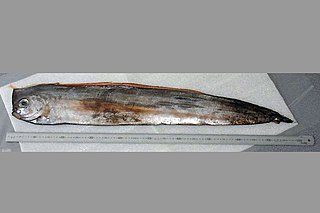 W
WThe crested bandfish is a species of crestfish in the family Lophotidae. It has a long string-like body, with large eyes, a red dorsal fin, elongated leading rays, and a short anal fin near the caudal fin. It grows up to 2 metres in length.
 W
WCtenacanthus is a prehistoric cartilaginous fish genus. Remains have been found in the Bloyd Formation in Arkansas, United States and in South America.
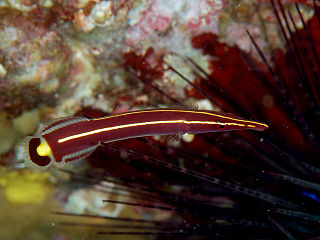 W
WDiademichthys lineatus, commonly known as the long-snout clingfish or urchin clingfish, is a species of marine fish in the family Gobiesocidae.
 W
WThe dusky darter is a species of freshwater ray-finned fish, a darter from the subfamily Etheostomatinae, part of the family Percidae, which also contains the perches, ruffes and pikeperches. It is found in, but not confined to, both large and small rivers, and shallow creeks, in the eastern, southern, and southeastern United States, particularly the Mississippi River drainage system.
 W
WThe elegant moray, or Goldsborough's moray eel, is a moray eel found in coral reefs in the Pacific and Indian Oceans. It was first named by Bliss in 1883.
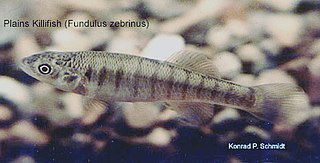 W
WFundulus zebrinus is a species of fish in the Fundulidae known by the common name plains killifish. It is native to North America, where it is distributed throughout the Mississippi River, Colorado River, and Rio Grande drainages, and other river systems; many of its occurrences represent introduced populations.
 W
WGephyroberyx japonicus, the big roughy or blueberry roughy, is a species of fish in the family Trachichthyidae. It is endemic to the northwest Pacific off Japan, Taiwan and Hawaii, and can be found at depths between 300 and 1,500 m (980–4,920 ft). It can reach 30–35 cm (12–14 in) in length. Based on broadly overlapping morphological features it is sometimes considered a synonym of G. darwinii.
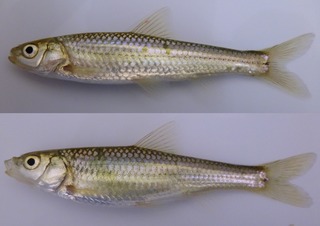 W
WGnathopogon caerulescens is a species of ray-finned fish in the genus Gnathopogon endemic to Lake Biwa in Japan.
 W
WThe Guadalupe bass is a rare species of fish endemic to the U.S. state of Texas, where it also is the official state fish. It is restricted to creeks and rivers, and is listed as near threatened. Today, most fly fishermen and anglers practice catch-and-release techniques to improve fish populations. The Guadalupe bass is often difficult to distinguish from the smallmouth bass or spotted bass, and the fish is known to hybridize.
 W
WGyrinocheilus aymonieri is a freshwater fish native to large parts of Southeast Asia. It is of interest as a local food source and for the aquarium trade. Its common names include honey sucker, sucking loach, Chinese algae eater, and Siamese algae eater; the FAO-endorsed common name is Siamese algae eater.
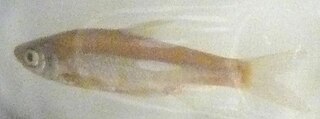 W
WIschikauia steenackeri is a species of cyprinid fish endemic to Lake Biwa in Japan. This species was originally described as Opsariichthys steenackeri. This species is the only member of its genus.
 W
WLabichthys carinatus is an eel in the family Nemichthyidae. It was described by Theodore Gill and John Adam Ryder in 1883. It is a marine, deep water-dwelling eel which is known from the western Indian Ocean, eastern and western Atlantic and eastern Pacific Ocean, including the Canary Islands, the United States, Brazil, and Madagascar. It is known to dwell at a depth range of 0 to 2,000 metres. Males can reach a maximum total length of 80 centimetres (31 in).
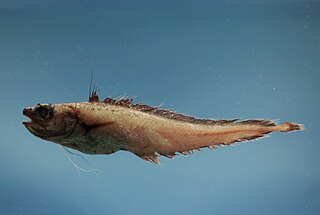 W
WThe short beard codling is a species of marine bony fish in the family Moridae. Native to the western Atlantic Ocean, it is found on the continental slope at depths between 50 and 1,620 m.
 W
WThe mangrove whipray or whitetail stingray, is a species of stingray in the family Dasyatidae. It is widely distributed in the Indo-Pacific region from the Red Sea to northern Australia and Micronesia. A benthic inhabitant of shallow inshore waters, juvenile mangrove whiprays favor mangrove and estuarine habitats, while adults favor sandy to rocky areas in lagoons and coral reefs. This species can be identified by its thick, oval pectoral fin disc that is dark gray above with numerous white flecks, and by its relatively short, whip-like tail that is white past the stinging spine. It grows up to 1.4 m (4.6 ft) across.
 W
WMicrolipophrys dalmatinus is a species of combtooth blenny found in the northeast Atlantic Ocean near Portugal, and the Mediterranean Sea. This species grows to a length of 4.1 centimetres (1.6 in) TL.
 W
WThe southern sunfish, also known as the Ramsay's sunfish, southern ocean sunfish, short sunfish or bump-head sunfish in many parts of the world, is a fish belonging to the family Molidae. It is closely related to its congener, much wider known Mola mola, and is found in the Southern Hemisphere. It can be found basking on its side occasionally near the surface, which is thought to be used to re-heat themselves after diving in cold water for prey, recharge their oxygen stores, and attract gulls to free them of parasites.
 W
WNeoditrema ransonnetii is a species of surfperch native to the Pacific coasts of Korea and Japan. This species grows to a length of 13 centimetres (5.1 in) FL. This species is the only known member of its genus. The specific name honours the Austrian diplomat, painter, lithographer, biologist and explorer Eugen von Ransonnet-Villez (1838-1926), who obtained the type specimens in Japan.
 W
WOmobranchus germaini, Germain's blenny, is a species of combtooth blenny found in coral reefs in the western Pacific ocean. This species can reach a length of 8 centimetres (3.1 in) TL. The specific name honours the collector of the type, the French military veterinarian Louis Rodolphe Germain (1827-1917).
 W
WThe ornate wobbegong is a species of carpet shark that lives in Australia and possibly other countries in the Western Pacific Ocean. It is coloured golden brown, yellow-green and blueish-grey, and it grows to about 2.0–2.5 metres (6.6–8.2 ft). Described by Charles Walter De Vis in 1883, it is similar in appearance to other Australian wobbegongs and has previously been classified as the same species as the Gulf wobbegong. It is a nocturnal species, hunting at night, and it can bite humans when disturbed. The International Union for Conservation of Nature has listed it as a least-concern species.
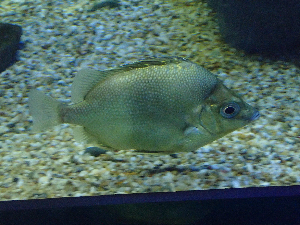 W
WPentaceros japonicus, the Japanese armorhead or Japanese boarfish, is a species of armorhead native to the western Pacific Ocean from southern Japan south to New Zealand and Australia. It occurs at depths from 100 to 830 m. It can reach a length of 25 cm (9.8 in). It is a commercially important species and can be found in the aquarium trade.
 W
WPeronedys anguillaris, the eel blenny, is a species of clinid found in estuaries of southern Australia where it only inhabits beds of eelgrasses where the living grasses are bedded in decaying grasses. It can reach a maximum length of 13 centimetres (5.1 in) TL.
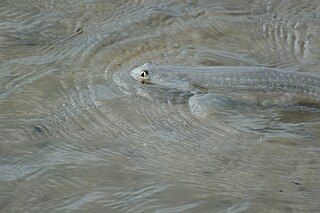 W
WThe shark mullet, also known as the sharp-nosed mullet or skipjack mullet, is a species of ray-finned fish from the grey mullet family Mugilidae. It is found in Australia and New Guinea where it occurs in muddy freshwater habitats and mangroves, it feeds on algae and insects taken from the surface but also on benthic invertebrates. It can breathe air and sometimes moves over exposed mud by wriggling. It was formerly classified in the genus Rhinomugil, with the corsula, but is now placed in its own monospecific genus, Squalomugil.
 W
WThe small-headed grunter is a species of fish in the family Terapontidae. It is endemic to Australia where it is known only from the upper Burdekin River in Queensland.
 W
WThe sooty grunter, also known by the name black bream, blubberlips, Northern grunter or purple grunter, is a species of freshwater ray-finned fish, a grunter from the family Terapontidae. It inhabits coastal and inland freshwater creeks and rivers of northern Australia.
 W
WSqualidus japonicus is a species of cyprinid fish found in Japan and the Korean peninsula.
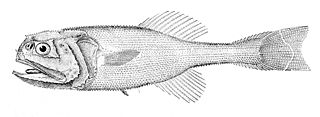 W
WStephanoberyx monae is a species of pricklefish found in the western Atlantic Ocean at depths of from 945 to 4,777 metres. This species grows to a length of 8.1 centimetres (3.2 in). This species is the only known member of its genus.
 W
WThe striped goby is a species of goby native to the Mediterranean Sea where it occurs on coralline grounds at depths of from 15 to 85 metres though normally not deeper than 50 metres (160 ft). This species can reach a length of 5.8 centimetres (2.3 in) SL. This species can also be found in the aquarium trade.
 W
WTaractichthys steindachneri, sickle pomfret, is a species of marine ray-finned fish, a pomfret of the family Bramidae. It is found in the Indian and Pacific Oceans.
 W
WThe threadfin jack or thread pompano is a species of coastal marine fish in the jack family Carangidae. The species inhabits the tropical waters of the eastern Pacific Ocean from Baja California in the north to Ecuador and the Galapagos Islands in the south. It is a moderately large fish, growing to 60 cm (24 in) and may be recognized by its filamentous dorsal and anal fin lobes. The threadfin jack inhabits both deeper coastal waters and inshore environments, including reefs and estuaries, where it preys on minute benthic and pelagic organisms, including small fishes and crustaceans. Very little is known about the ecology and reproductive cycle in the species. The threadfin jack is of importance to fisheries throughout its distribution, caught by hook-and-line and net methods and marketed fresh and salted, and is considered a very good table fish. The species was named Carangoides dorsalis by Theodore Gill 20 years before the name Caranx otrynter was introduced, but confusion with Vomer dorsalis led to the proposal of the new name to separate the two species.
 W
WThe threespot grunter is a species of freshwater ray-finned fish in the family Terapontidae. It is endemic to Papua New Guinea, where it is found only in the Laloki River near Port Moresby living in rock pools in the lower part of the river. The eggs are guarded and fanned by the male.
 W
WThe triplewart seadevil is a sea devil of the family Ceratiidae and the order Lophoiiformes. This species is the only member of its genus. Noted for its extreme sexual dimorphism, the triplewart seadevil length ranges from 20 to 30 cm for females and 1 to 3 cm for males.
 W
WVenefica procera is an eel in the family Nettastomatidae. It was described by George Brown Goode and Tarleton Hoffman Bean in 1883, originally under the genus Nettastoma. It is a marine, deep water-dwelling eel which is known from the western central Atlantic Ocean, including North Carolina, USA, Suriname, the Gulf of Mexico and the Caribbean Sea. It dwells at a depth range of 326 to 2,304 metres. Males can reach a maximum total length of 109 centimetres (43 in).
 W
WThe Yellowstone cutthroat trout is a subspecies of the cutthroat trout. It is a freshwater fish in the salmon family. Native only to a few U.S. states, their original range was upstream of Shoshone Falls on the Snake River and tributaries in Wyoming, also across the Continental Divide in Yellowstone Lake and in the Yellowstone River as well as its tributaries downstream to the Tongue River in Montana. The species is also found in Idaho, Utah and Nevada.